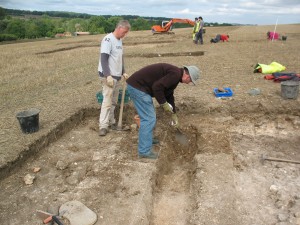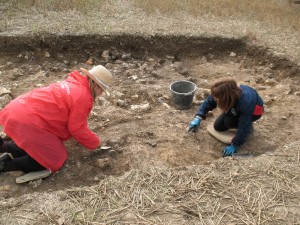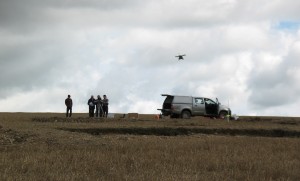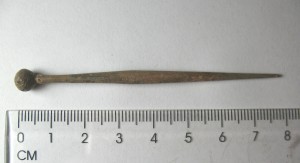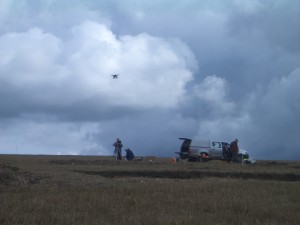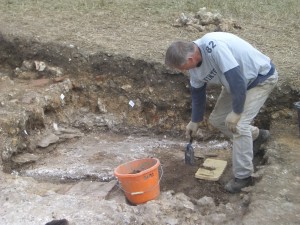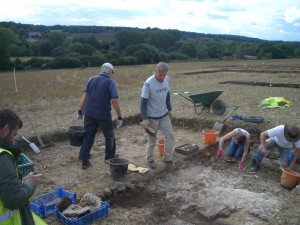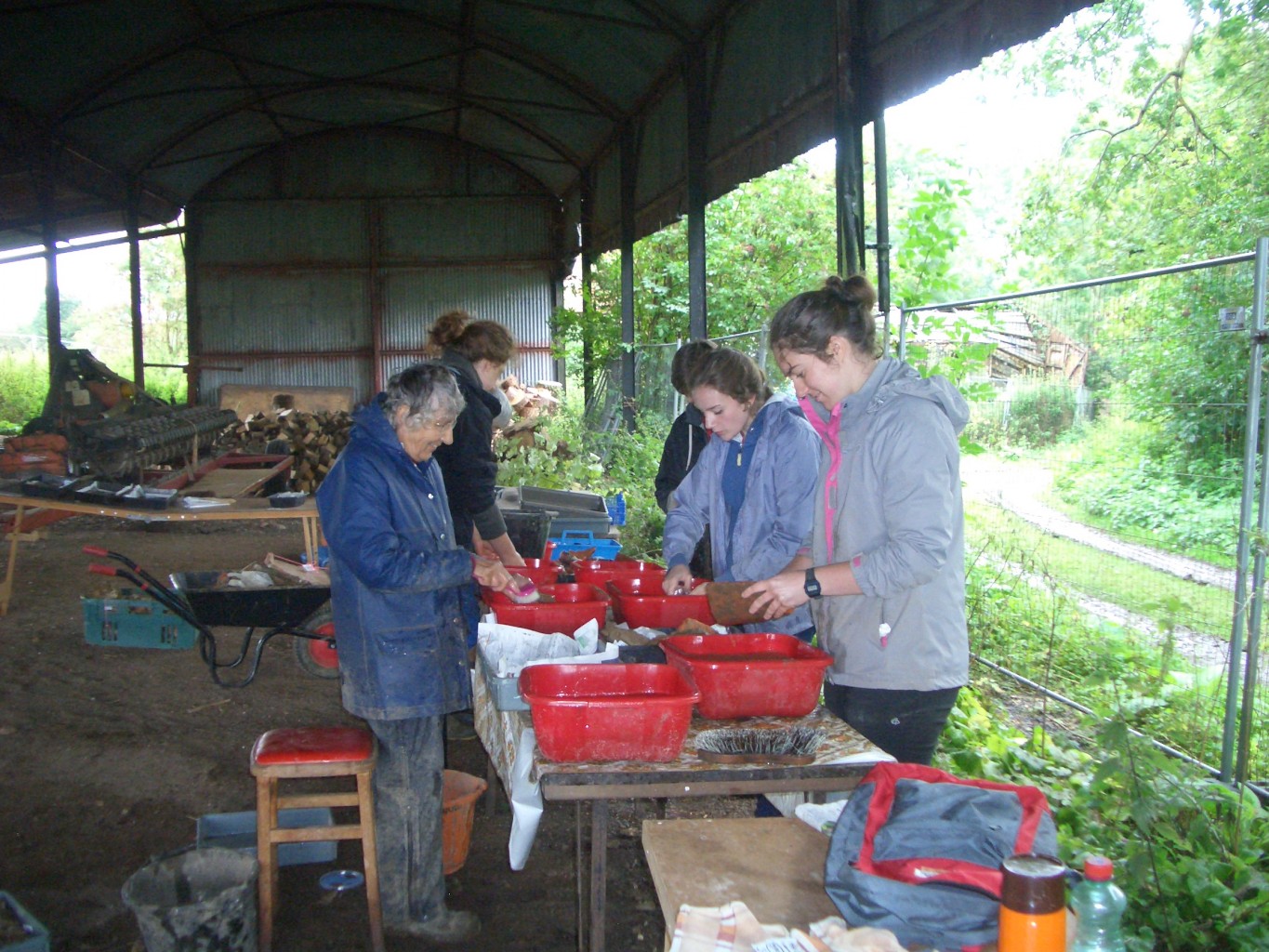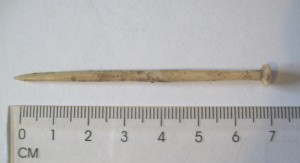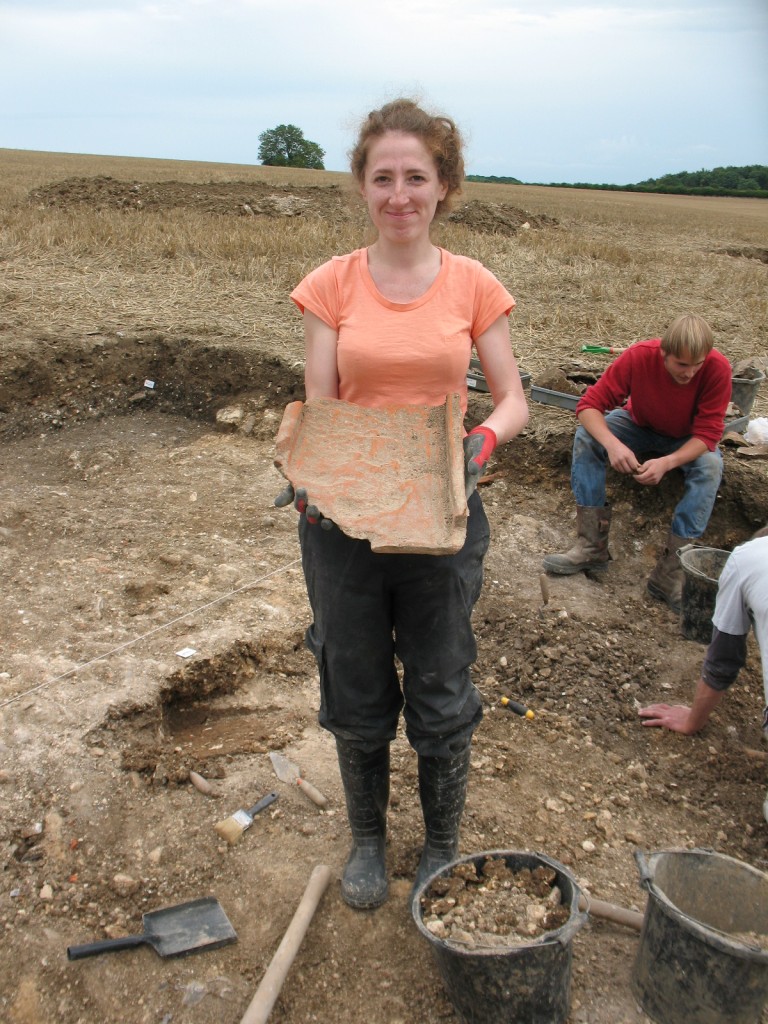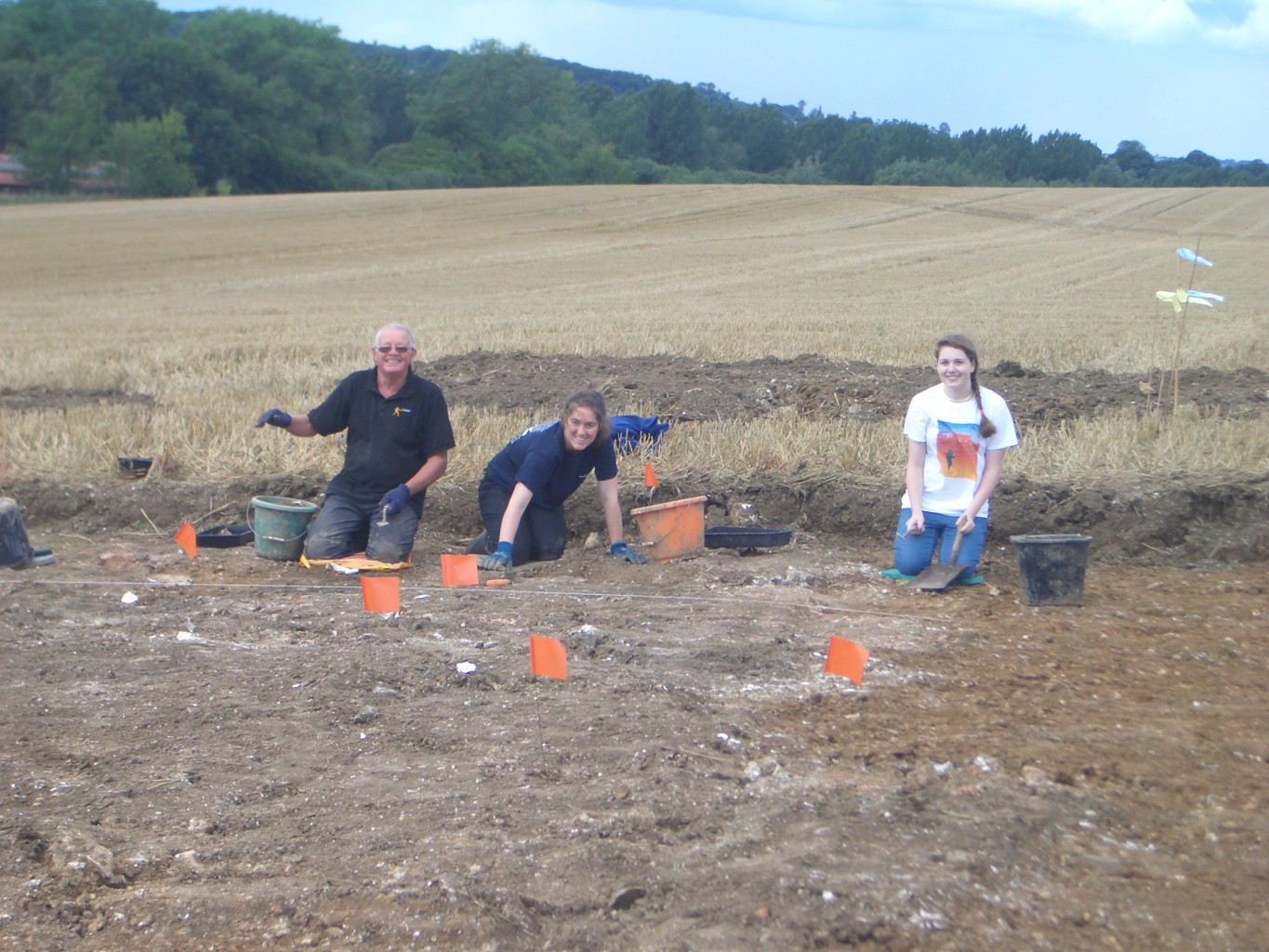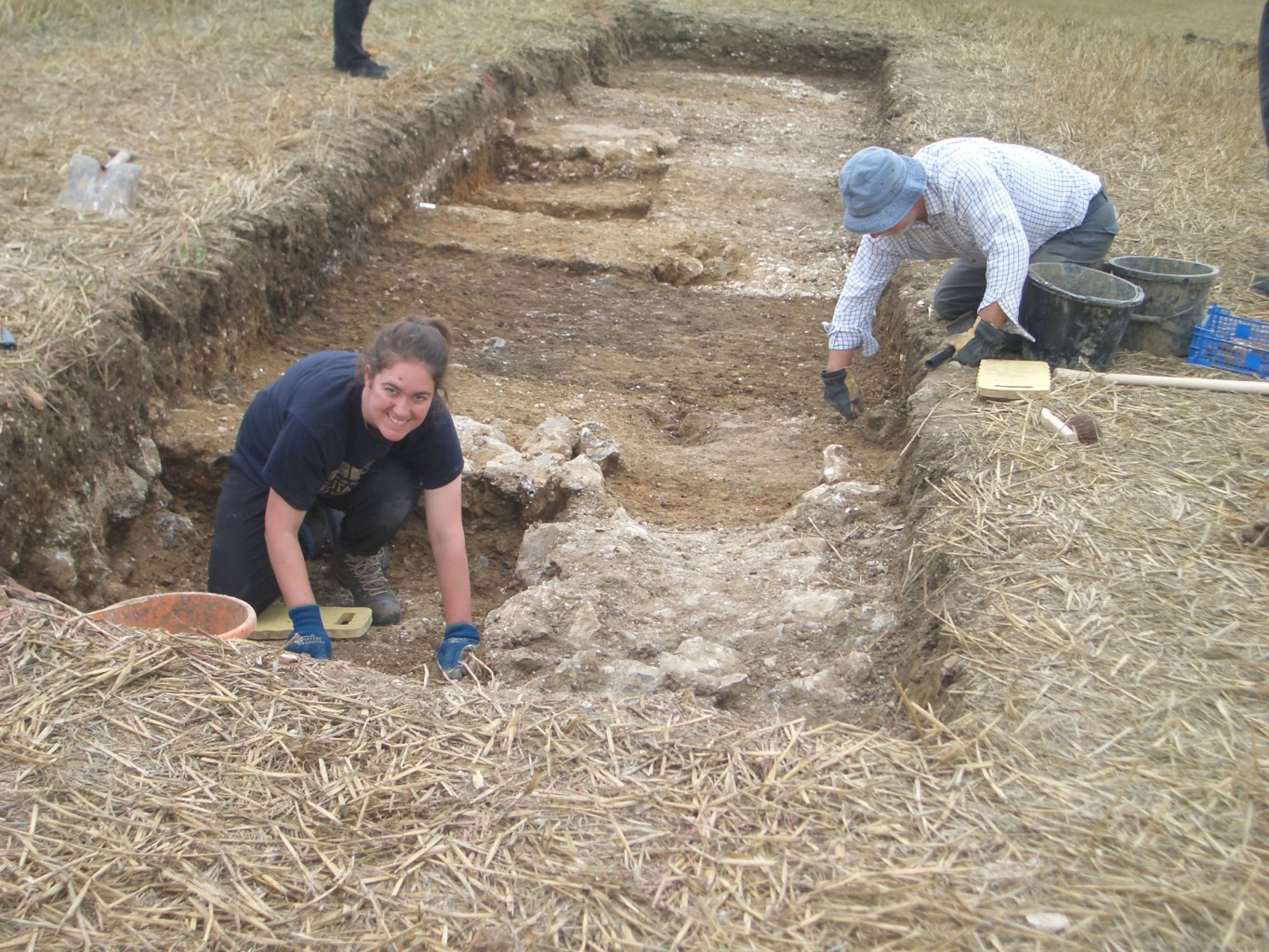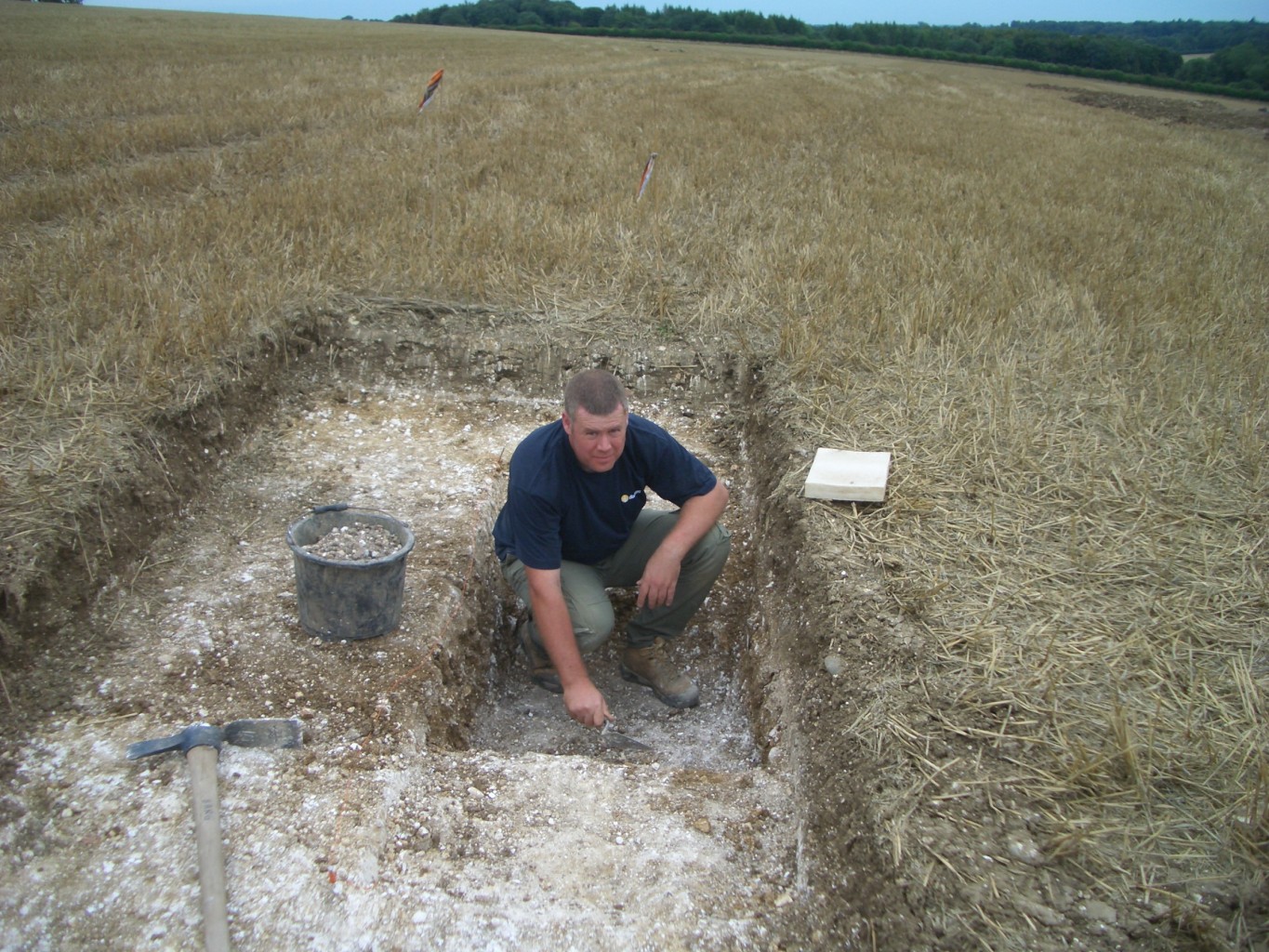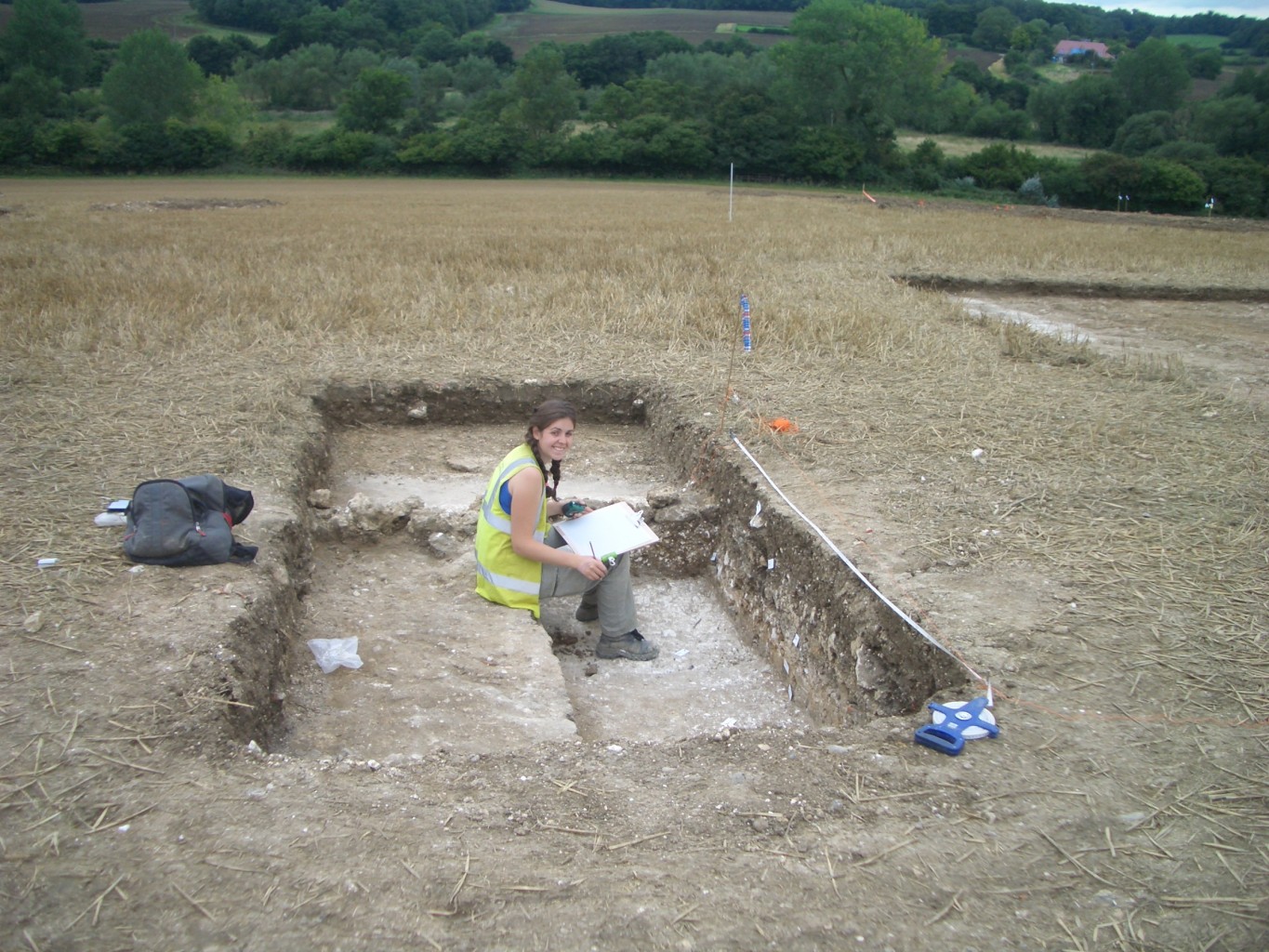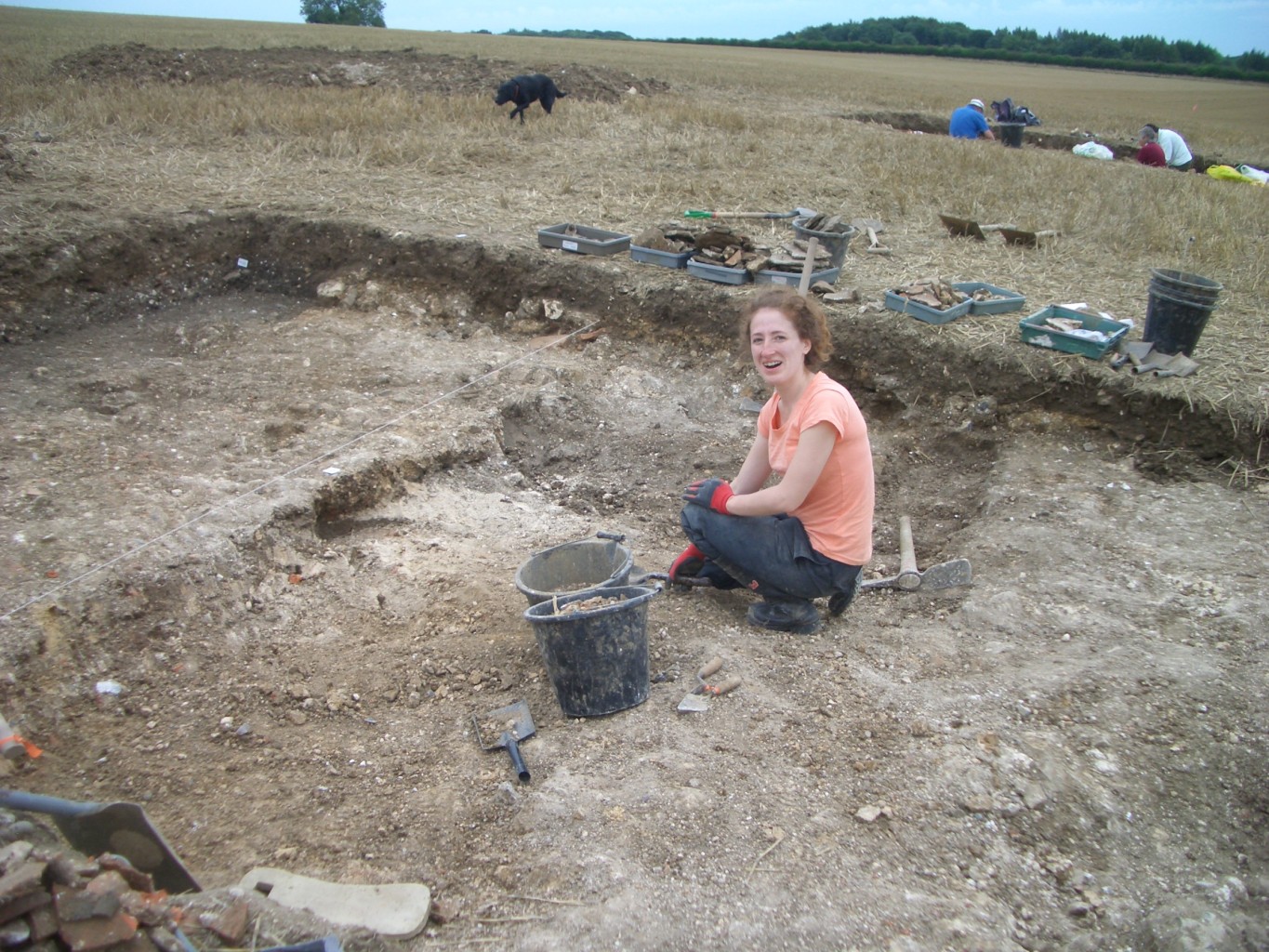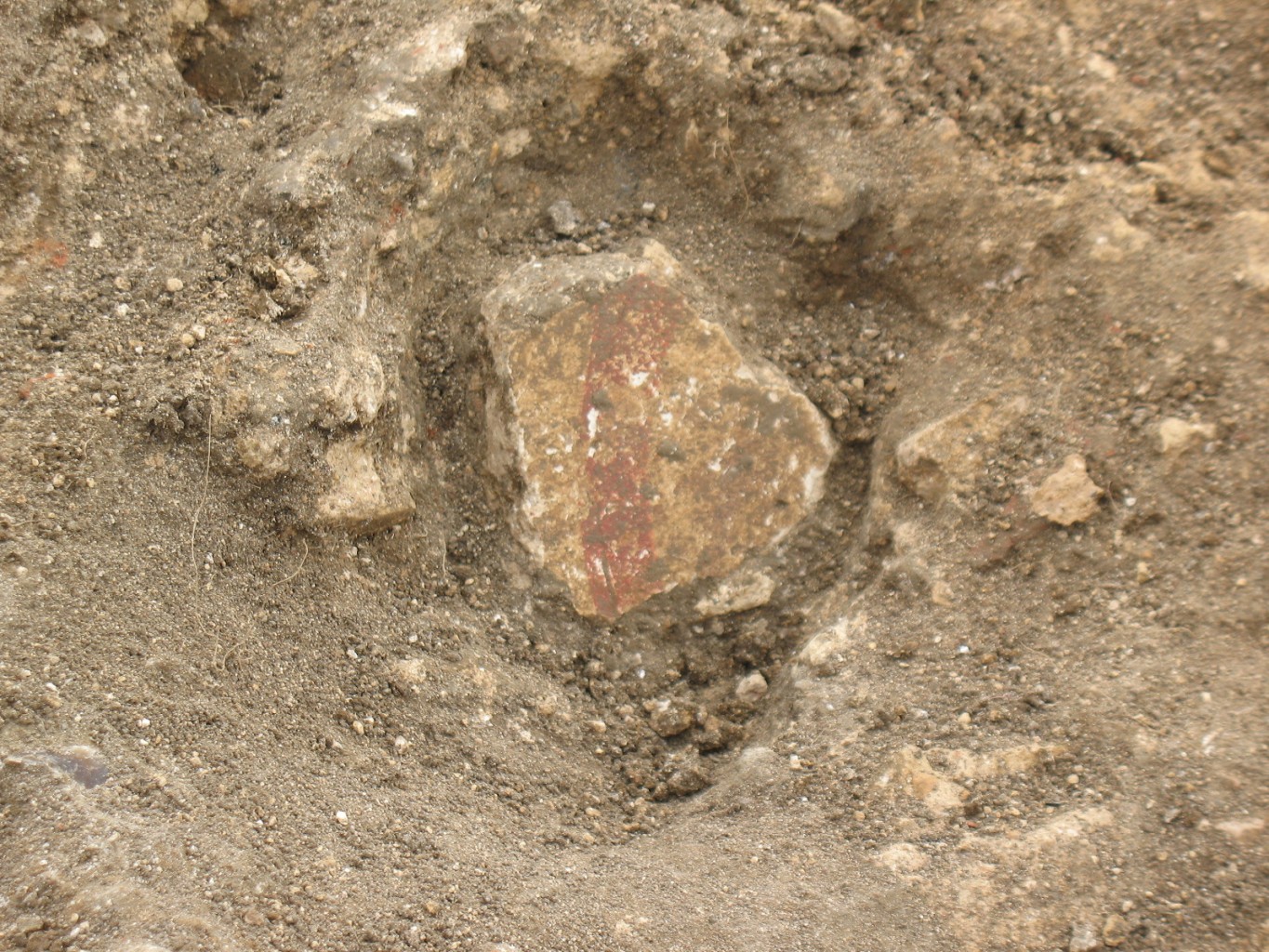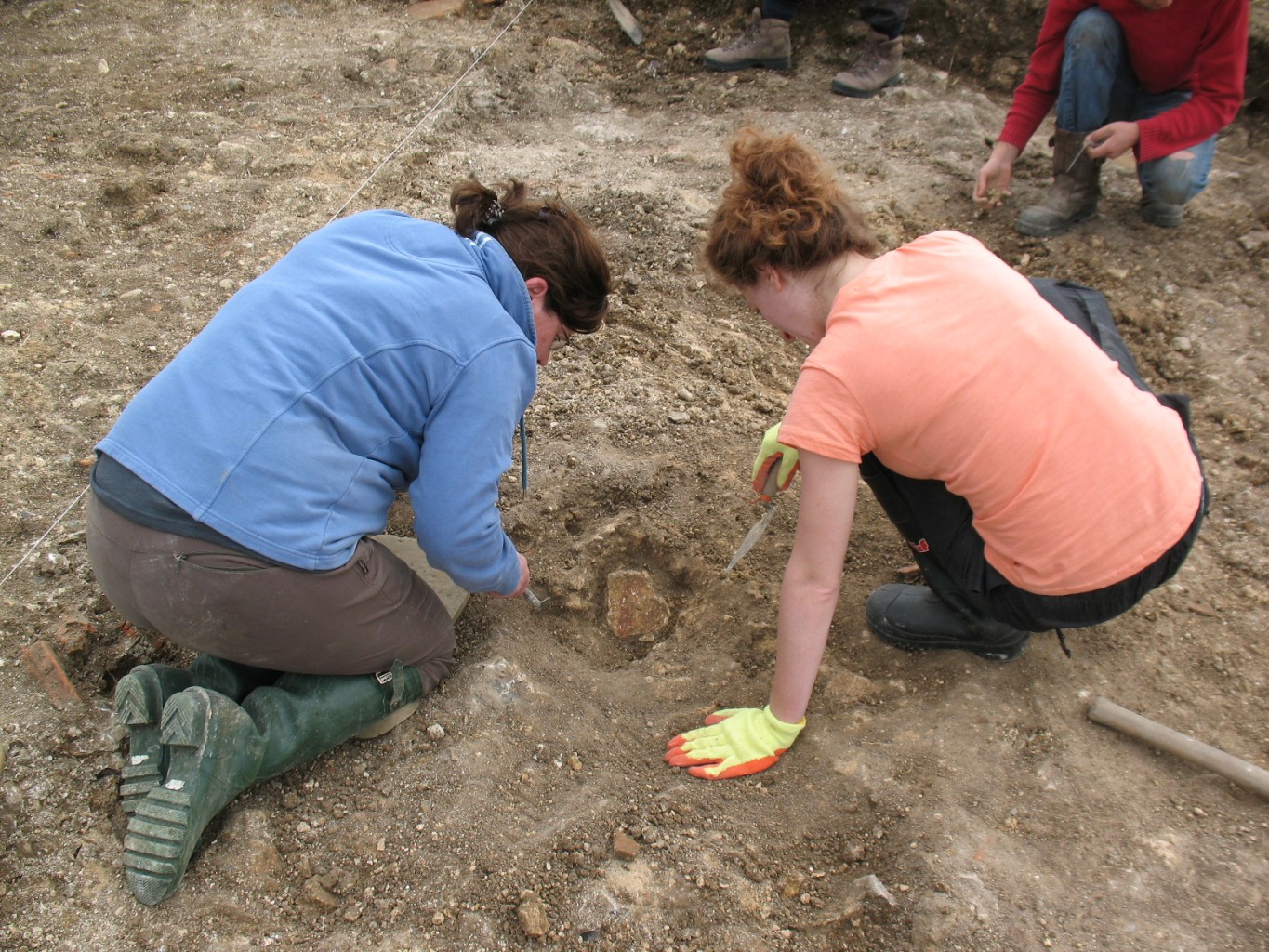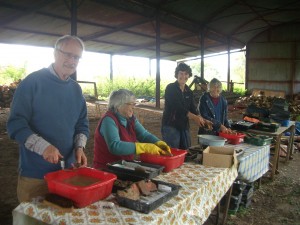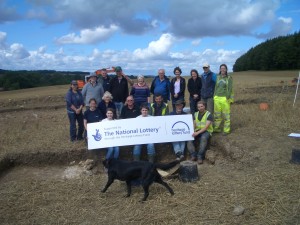Page 14 of 17
Some useful small finds today – the students patiently working away in their ditch trench eventually had their rewards with some nice pottery shards and animal bone finds. Gary in the main entrance trench, managed to find another delicate bone pin under the rubble – sorry no photo at this moment in time. There was an awful lot of cbm and limestone roofing from trench 4 but much excitement at seeing flue tile under a wall suggesting the hot air underfloor heating from one room to another. It’s really great to be able to piece each element of the site together and begin to see a clearer picture of the building within it’s landscape.
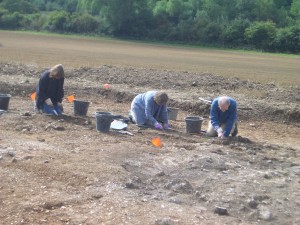
Sue, Isobel and Bob have found a few pieces of tesserae in the bath house and are looking for more – a picture of Neptune perhaps!
Well, we thought we would see the floor of the main entrance once the limestone roof tiles from the collapsed building were cleared away but what did we see? More cbm! (ceramic building material) The limestone roof tiles can be seen in a layer to the left of the picture. This has all got to be cleared away before we see the floor – very frustrating and tantalising. Gary was remarkably calm and stoic about it all and gamely carried on digging all day. However a couple of nice surprises were the finds of a small piece of window glass which shows what a high class place this villa was, together with a beautiful piece of decorated wall plaster. We also found the underfloor heating channel – so central heating 1800 odd years ago. What an entrance – built to impress!
Neil Holbrooke, Time Team’s Roman specialist visited the villa site today. He seemed pretty impressed with the site as a whole and had a rummage through the finds pointing out 4th century pottery amongst other things. He chatted to some of our committed young students who have been coming every day.
We might be getting closer to finding out if the main entrance floor is special. Digging in this area has gone down to a level where we can see the limestone roof tile collapse, usually the first to go – which has covered one area of the floor at least. It’s a good sign and the archaeologists think it might have protected the floor from further damage and robbery!
Pot washing may not seem very glamorous but it takes careful hands and concentration to remove years of mud from tiles, bricks, pots, painted plaster, bone, shells and metal work. A huge amount had been brought down from the site on Saturday, so it was a major task to clear it all before digging starts again. So whilst the rain poured down outside, we were working hard in the barn. After the artefacts are washed , they are photographed, their site location and any significant marks are recorded.
Many limestone and clay tiles had fallen from the collapsed roof into the main entrance of the villa, covering the floor. There is still much more debris to clear from here. It’s amazing then to find small items unbroken like the bone pin.
With an improvement in the weather, everyone today made a big effort to clear the remaining topsoil off the largest of our trenches to reveal walls with coloured plaster work. This may be all we have time for, since there is more to be done on the main entrance and our new and confirmed discovery of a separate building of Roman baths. One find of about 50 tiny beads – probably bone or glass and another of some Roman snail shells – a great delicacy, have made us appreciate more the Roman appetite for beauty and food! There was some lovely pottery too albeit broken, from the Roman Bath house. We need plenty of muscle on Saturday and Bank Holiday Monday to get lower down in these trenches – so if you’re free please come along to the Black Barn or email joy@appleton.uk.net for more details.
The biggest surprise today was the find of another building – a little way from the villa but it appears to have waterproof mortar and a void under one section so we are becoming very excited at the prospect of having found a Roman bath house! Tomorrow should make things more certain when we continue digging here.
Tuesday
It was wonderful to see so many people arrive this morning all eager to get started despite the atrocious weather! The day was started by a induction delivered by Duncan Coe about site safety an good practice and a talk given by Tom, both from Cotswold Archaeology, about the types of finds we are likely to encounter during our excavation and the finds processing techniques we need to implement to sort, clean where appropriate, label and store securely.
Whilst this was going ahead the first trenches over the villa were being opened by mechanical digger whilst the remaining trenches were being surveyed and flagged into the grid.
At long last the volunteers, who had been patiently watching as the digger cleared the first trenches were told to gather their gear and assigned the trenches to put their training into practice.
The weather was ‘challenging’ (!) to say the least but good progress was made and some lovely finds uncovered including 3 coins, a small 1st century brooch and a wonderful intact bone pin. A great start indeed.
Wednesday
A second wet day tried but failed to dampen spirits. It was decided to leave the large trench 2 alone to dry out a bit so trenches 4 and 5 were started. Trench 4, being in the middle of the main range may have an entrance, perhaps just coming into view and trench 5 showed a possible ‘dog leg’ in the external wall. As the weather cleared in the afternoon trench 3 was started which was placed over where we had dug in 2013 but only down to topsoil level to expose the tops of walls. This time we are extending the trench and going down deeper to explore amongst other things, whether it mirrors the northwest wing.
A small team worked enormously hard and very successfully in the barn to keep on top of the finds that were being generated.
The digger completed opening all the trenches with many really exciting prospects. Watch this space!
